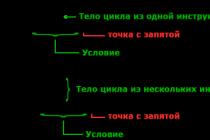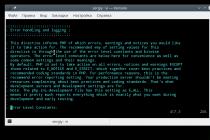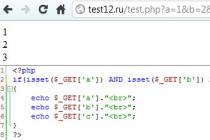An information war is the seizure of raw materials, energy, and other resources of a foreign country through the dissemination of false information on its territory and manipulation of the consciousness of the population, which eliminates the ability of this population to resist.
The term "information war" came into focus with the 1991 Gulf War. This then meant disinformation and physical actions aimed at destroying Iraqi information systems - both military (radio and computer communications) and civilian (propaganda). To this we can add Western television companies broadcasting from Iraq. Moreover, these broadcasts were directed not at the enemy, but, on the contrary, at citizens of Western countries.
After the Gulf War, theorists of "information warfare" appeared.
In August 1995, Martin Libiki's classic work in this field was published by the US National Institute of Defense. In it, the author identified 7 forms of information warfare:
1. Command and control in the modern sense is aimed at communication channels between the command and the executors and aims at depriving control.
2. Intelligence warfare - the collection of militarily important information (like an attack) and the protection of one's own.
3. Electronic warfare - directed against the means of electronic communications - radio communications, radar stations, computer networks.
4. Psychological warfare - propaganda, brainwashing, information processing of the population. Libiki divided it into 4 components - the undermining of civil spirit, the demoralization of the Armed Forces, the disorientation of the command and the war of cultures.
5. Hacker war means sabotage actions against civilian objects of the enemy and protection from them (actions against the military are regarded as electronic warfare). The actions of hackers can lead to a total paralysis of networks, communication interruptions, the introduction of random errors in data transmission, storage of information and services (unauthorized connections to networks), secret monitoring of networks, unauthorized access to confidential data for the purpose of blackmail. The weapons of hackers, according to Libiki, are computer viruses. Libiki sees hackers as a serious threat to the US because America is the most "networked" country.
6. Cyber warfare is different from "normal" hacking. This is the capture of computer data that allows you to track down the target (or blackmail him).
Libiki singled out semantic attacks in a special direction. He sees the difference between a semantic attack and hacking in that the hacker, roughly speaking, makes the system work incorrectly. In a semantic attack, the computer system works exactly right, but the solutions it produces are wrong. A semantic attack is aimed at the "sense organs" of a computer system that controls a process with the help of sensors. To deceive these sensors or other means of input means to disable the system without breaking anything in it.
Based on the theater of operations, information warfare can be waged in various areas.
The electronic battlefield is represented by an ever-growing arsenal of electronic weapons, mostly classified. They are intended for combat operations in the field of command and control, or "headquarters warfare".
Infrastructure attacks target vital elements such as telecommunications or transportation systems. Such actions may be taken by geopolitical or economic adversaries or terrorist groups.
Industrial espionage and other types of intelligence are carried out by corporations or states against other corporations or states; for example, the gathering of intelligence information about competitors, the theft of proprietary information, and even acts of sabotage in the form of corruption or destruction of data or services.
Confidentiality is becoming increasingly vulnerable as ever-increasing volumes of information can be accessed in an increasing number of subscriber stations. VIPs are thus subject to blackmail or vicious slander, and no one is safe from the false use of personal identification numbers.
The speed with which modern information and telecommunication technologies have burst into our lives has made it possible to speak of a "digital revolution" that is already transforming social and economic life. The communications and information industry is undergoing fundamental changes. It took radio 38 years and television 13 years to reach 50 million people. In just 4 years, the same number of people began to use the Internet.
In 1993, there were only 50 pages on the "global web"; Today there are more than 1 billion of them. In 1998, only 143 million people were connected to the Internet, by 2001 the number of users reached 700 million people, and now there are about 2 billion. The Internet is already used in a much wider area than any of the previously used means of communication.
Such impressive, and most importantly, lightning-fast changes have led to the fact that the desire to maintain global leadership is forcing the leadership of the world's leading countries to reconsider their approach to conducting foreign and domestic policies.
Essence and features of information warfare
The term "information war" came into focus with the 1991 Gulf War. This then meant disinformation and physical actions aimed at destroying Iraqi information systems - both military (radio and computer communications) and civilian (propaganda). To this we can add Western television companies broadcasting from Iraq. Moreover, these broadcasts were directed not at the enemy, but, on the contrary, at citizens of Western countries.
After the Gulf War, theorists of "information warfare" appeared.
In August 1995, Martin Libiki's classic work in this field was published by the US National Institute of Defense. In it, the author identified 7 forms of information warfare:
- 1. Command and control in the modern sense is aimed at communication channels between the command and the executors and aims at depriving control.
- 2. Intelligence warfare - the collection of militarily important information (like an attack) and the protection of one's own.
- 3. Electronic warfare - directed against the means of electronic communications - radio communications, radar stations, computer networks.
- 4. Psychological warfare - propaganda, brainwashing, information processing of the population. Libiki divided it into 4 components - the undermining of civil spirit, the demoralization of the Armed Forces, the disorientation of the command and the war of cultures.
- 5. Hacker war means sabotage actions against civilian objects of the enemy and protection from them (actions against the military are regarded as electronic warfare). The actions of hackers can lead to a total paralysis of networks, communication interruptions, the introduction of random errors in data transmission, storage of information and services (unauthorized connections to networks), secret monitoring of networks, unauthorized access to confidential data for the purpose of blackmail. The weapons of hackers, according to Libiki, are computer viruses. Libiki sees hackers as a serious threat to the US because America is the most "networked" country.
- 6. Economic information war. Libiki sees two forms of it - information blockade (directed against the USA) and information imperialism (the method of the USA itself). The blockade means, first of all, the blocking of commercial channels (similar to the ban on "physical" trade). Hacking banking networks is not included in this category (this is the category of hacker warfare). Information imperialism is part of the general policy of economic imperialism.
- 7. Cyber warfare is different from "normal" hacking. This is the capture of computer data that allows you to track down the target (or blackmail him).
Libiki singled out semantic attacks in a special direction. He sees the difference between a semantic attack and hacking in that the hacker, roughly speaking, makes the system work incorrectly. In a semantic attack, the computer system works exactly right, but the solutions it produces are wrong. A semantic attack is aimed at the "sense organs" of a computer system that controls a process with the help of sensors. To deceive these sensors or other means of input means to disable the system without breaking anything in it.
Based on the theater of operations, information warfare can be waged in various areas.
The electronic battlefield is represented by an ever-growing arsenal of electronic weapons, mostly classified. They are intended for combat operations in the field of command and control, or "headquarters warfare".
Infrastructure attacks target vital elements such as telecommunications or transportation systems. Such actions may be taken by geopolitical or economic adversaries or terrorist groups.
Industrial espionage and other types of intelligence are carried out by corporations or states against other corporations or states; for example, the gathering of intelligence information about competitors, the theft of proprietary information, and even acts of sabotage in the form of corruption or destruction of data or services.
Confidentiality is becoming increasingly vulnerable as ever-increasing volumes of information can be accessed in an increasing number of subscriber stations. VIPs are thus subject to blackmail or vicious slander, and no one is safe from the false use of personal identification numbers.
In the mid-1970s, when the confrontation between the socialist and capitalist camps was in full swing, a new term appeared - "information war". It was invented by the physicist Thomas Rohn, who was not only the first to understand, but also scientifically substantiated that information is the weakest link in any army.
The techniques and methods used to wage such a war are similar to atomic energy, which can serve people, or can be used for their mass destruction. Information warfare technologies are another "double-edged sword" because they can be used both for evil and for good. It all depends on the purpose for which the information war is waged: for self-defense or for the preparation of hostile actions against another state. In the first case, the mechanisms of information warfare help society and each individual to develop steadily, becoming its reliable support in life, and in the second, they lead to complete social decline and ruin.
What is the modern information war? Its main goal is to use special technologies to influence the ideological enemy and at the same time reliably protect their own information resources from any hostile influence. In other words, the meaning of the information war is to inflict severe cultural trauma on the population of a certain country. This is a “violent, unexpected, repressive introduction of values that sharply contradict traditional customs and value scales”, which leads to the destruction of cultural time-space, and hence the spiritual foundations on which any society rests.
The information war is, first of all, the invasion of certain ideas that destroy the national identity of an entire nation. This is precisely her strategy. There are even more tactics, tricks, methods, tricks in the information war than in a conventional war, where they only shoot and blow up. Indeed, "an information bomb explodes in the midst of people, showering us with shrapnel of images, radically changing both the perception of our inner world and our behavior."
One should not think that information wars appeared only in the 20th century. In fact, they have been going on since the moment when humanity arose. From ancient times, information has come down to us about attempts to misinform the enemy, intimidate him and thereby undermine morale. The art of controlling people's thoughts and actions was developed and used as a secret weapon by the rulers of Sumer, Babylon, Ancient Egypt, China, Ancient Greece and Rome. In the writings of Herodotus, Plutarch, Julius Caesar, one can find a description of some techniques that can undermine the will to resist, cause betrayal or provoke panic. For this, rumors were spread about the prevailing number of their troops and their invincibility; about the presence of a new powerful weapon; about treason, captivity or flight of command; good treatment of prisoners, etc.
Thanks to new technical means today it is possible to cover millions of people with propaganda at the same time. Organizations have also appeared that are capable of staging political spectacles that were previously unimaginable in scale in the form of mass spectacles or bloody provocations. Strange forms of art have emerged that have a strong impact on the psyche (for example, performance art that turns everyday reality into a bewitching performance). Today, Hollywood, CNN and similar "media monsters" are actively involved in the conduct of information wars.
The information war has advantageous differences compared to other wars:
- 1. Such wars, as a rule, are fought on foreign territory. For them there are no boundaries, no moral restrictions. Because of this, informational attacks are able to penetrate even the most forbidden recesses of the psyche, striking the mind of the enemy.
- 2. The information war leaves no traces behind. It seems to a person (or even a whole society) that he makes independent decisions, although in fact he is influenced by a hidden influence. For this reason, an information attack becomes especially dangerous: it is very difficult to repel it, not to mention preparing for it in advance.
- 3. Information warfare is very beneficial from an economic point of view. It does not require large material and human resources. A minimum amount of information is enough to influence public opinion. If it is properly served, it will give excellent results.
- 4. Features of the information war are determined by the object to which it is directed. In this case, we are talking about human thinking. If the destruction of the bridge requires "hard" methods, then in the case of information, it is quite possible to get by with "soft" approaches.
- 5. Information warfare is characterized by a certain "mimicry", imitation of the object to which its main impact is directed. This means that the same information can be presented differently for specialized institutions and for a particular person. Thanks to this, the “invisibility” of a targeted informational influence is achieved, which is successfully “disguised” as the truth, and therefore it is difficult to detect.
- 6. The same facts and social phenomena are perceived differently in different situations. For example, the mass desertion of soldiers from the point of view of the enemy will be considered as a blessing, and from the point of view of their own command - as a crime.
- 7. The information war aims to change the outlook of a large social group or a whole society. For this to happen, the “attacking side” must delve into the ideas about the world of its opponent, become at his level of thinking.
Today, developed countries are more and more successfully mastering the technologies of information warfare, which has received another name - "network warfare". Its main goal is to establish control over important processes (political, economic, social, spiritual) taking place in another country, and maintain it for as long as possible. Well-thought-out, well-organized propaganda and coordination work carried out in society help, if necessary, to quickly mobilize the masses and start a revolution.
The strategy of network warfare, also called “sixth generation warfare,” has been officially adopted by the Pentagon. It allows us to seize foreign territories and establish American control over them without the use of conventional weapons. Therefore, a network war is precisely a war, therefore, it must be taken with all seriousness. One of the methods of information warfare is the creation of public organizations that promote the values of Western culture in society. It is this process that is actively taking place in the post-Soviet space today. Thus, foreign intelligence services undermine national spiritual values. At a certain stage, it is the network of such organizations that turns into the engine of "color" revolutions. As a result, the US administration is able to manipulate entire countries in its own interests. The American military doctrine lays down the continuous and never-ending nature of network warfare. This means that over time, this state will be able to establish total control over all the forces of mankind. A variety of tools are used to achieve this goal: non-governmental organizations, charitable foundations (for example, the Soros Foundation), nationalist, religious and other radical movements, criminal groups, the media, and Internet sites. Separate elements of one system are not always aware that they are participating in a united front in the information war against Russia.
All military propaganda, all cries, lies and hatred, always come from people who will not go to this war.
George Orwell
Why do wars start? This question looks somewhat strange: of course, in order to gain victory and defeat the adversary. But what is victory? Complete and total destruction of the enemy? This has also happened more than once in the history of mankind, but harsh genocide is the exception rather than the rule. Most often, they start a war in order to impose their will on the enemy, to force him to give up his own ideology, part of his freedom, and to force him to do what you need. Any military conflict is an act of armed violence that pursues purely political and economic goals.
Defeat in a war is the state of one of the parties when it is no longer able to resist and refuses to fight. History knows a lot of examples when a defeated enemy had all the necessary material resources to continue hostilities, but had no moral strength and surrendered to the mercy of the winner. This is the real quiz. It can be achieved not only with the help of tanks, guns or carpet bombing, but also with the use of more subtle tools aimed at the mind of the enemy. Today, such actions are called information warfare. It can be directed not only at the armed forces of the enemy and the population of the enemy country, but also at the soldiers of their own army and their own citizens.
The concept of information warfare appeared only a few decades ago, but in fact this war is as old as our world. Mankind learned to lead it many thousands of years ago. Sometimes such a war is also called psychological, and in a broad sense, it is a set of actions aimed at changing the consciousness of your enemy, introducing the installations you need into him. Information warfare (WW) can be conducted either directly in the course of hostilities, or precede them. The main task of the IW in wartime is to demoralize the enemy army, break its will to resist, and persuade it to capitulate. The information war is inextricably linked with such a term as propaganda.
History of information wars
Conducting an information war is often the responsibility of various intelligence structures, although there are also special units and organizations that deal with this issue. In the USSR, it was the 7th Directorate of the GlavPUR of the Red Army, in the Third Reich - the Ministry of Education and Propaganda, and in the USA - the Bureau of Information. Professional propagandists first appeared during the First World War.
Methods of information warfare are different and varied. The oldest known is intimidation of the enemy. For example, the Persian king Xerxes I, before invading Greece, spread rumors through his agents about the invincibility of his army: "... if all the Persian soldiers shoot from bows, then the arrows will eclipse the sun". Disinformation about a secret weapon from which there is no escape worked well. So did Genghis Khan and Hannibal. In order to achieve the obedience of the population of the occupied territories, total terror was often staged against it, bordering on genocide. Any attempt to resist the invaders was suppressed as bloodily and defiantly as possible. With the help of such actions, terror was instilled in the hearts of people and forced them to give up further struggle. This is what the Mongols used to do.
Another proven way of conducting psychological warfare is to split the enemy camp. It is necessary to sow confusion among the enemies, deprive them of unity, and ideally force them to kill each other. If you are acting against a coalition, then you need to destroy it and beat the enemies one by one.
The main method of IW is disinformation. At different times, it was reported to the enemy in the most bizarre ways - as far as talent and imagination were enough. A typical way is to throw a scout into the camp of the enemy. But sometimes more interesting options were used. Once again defeating the Hungarians, the Mongols seized the personal seal of the Hungarian king and began to print decrees on his behalf to end resistance to the invaders. Then they were sent to all parts of Hungary.
The favorite technology of information warfare in the Middle Ages was the incitement to rebellion of a part of the feudal nobility of the enemy state.
Given the authority of the church, in the past it was often involved in the conduct of the information war. For example, during the war of 1812, the Catholic Napoleon was twice anathematized by the Moscow Orthodox Church, which was announced to Russian subjects. True, between excommunications, he was awarded the highest award of the empire - the Order of St. Andrew the First-Called.
With the advent of typography and the gradual penetration of literacy into the masses, the information war has increasingly begun to use the printed word. Thus began the information war in the media. A leaflet became a typical carrier of propaganda and disinformation, they were delivered to enemy soldiers or the population in various ways. On an "industrial" scale, the use of leaflets began during the First World War. In the same period, the main participants in the conflict created special services that were engaged in propaganda.
In general, it should be said that it was the First World War that gave an unprecedented impetus to the development of information means of warfare. After the end of this conflict, a significant number of researchers began to develop the theoretical basis of psychological warfare. For the first time, a definition appeared that the purpose of the war is not to destroy the army of the enemy, but to undermine the morale of the entire population of the enemy state to such an extent that it forces its government to capitulate.
Surprisingly, the first World War clearly showed that propaganda should first of all be directed at its own population and the army. The best propagandists of WWI were the British. Among other things, they were the first to think of creating agitation shells, agitmins and even rifle agitation grenades.
One of the brilliant information warfare technologies that the perfidious Anglo-Saxons used against the Germans was the so-called horror propaganda. The most famous newspapers published completely fake materials about the cruelties and atrocities of the German troops: violence against nuns, executions of priests, brutal murders of captured British soldiers. A typical example of a fake of that time is the story of a crucified Canadian soldier, so the plot of the Ukrainian media about the attempt on the life of the former journalist Babchenko is a dull plagiarism with some trash added.
The most vile fictional story of the time is the English fake about the Germans processing the corpses of their own and other soldiers to feed pigs. It caused a whole storm of indignation all over the world: after this news, China joined the Entente, and in England itself and in America, the material caused an unprecedented influx of volunteers who wanted to go to the front. Like, how is it, brothers? Feed the fallen gentlemen to the pigs?! Let's kick those nasty Teutons' asses!
It should be noted that the materials were perfectly fabricated - all the facts were confirmed by trained witnesses, and people really believed in them.
The Germans also tried to do something similar: they told their population that the Russian Cossacks eat babies (again they were believed). This forced the German soldiers at the front to fight even more heroically in order to protect Vaterland from wild Asian cannibals.
Here we should make one small digression. It is not normal for a mentally healthy person to take the lives of their own kind in the name of incomprehensible political interests or abstract ideas. Therefore, the main task of any propagandist is to “dehumanize” the enemy. Like, look: they eat babies or crucify children on bulletin boards - well, what kind of people are they? Fuck them guys! Bay kill!
The fact is that during the war the human psyche works a little differently than in normal peacetime. Stress makes the deepest mechanisms of our personality work and clearly divides the world into “us” and “them”. In many ways, a person loses the ability to critically assess reality and can believe the most ridiculous stories.
Another direction of the English propaganda of the WWII was to downplay their own losses and exaggerate military achievements. Naturally, the soldiers of the Entente were portrayed in the newspapers as noble and fearless knights.
Led by British propaganda during the First World War, Lord Northcliffe. We can say that this person raised the information war to a whole new level. Today, every literate person knows the name of Hitler's Minister of Propaganda Goebbels. However, there is no doubt that this evil genius of Hitler had very good teachers and proven methods of turning the average citizen into a murderer and a monster.
It cannot be said that Lord Northcliffe discovered something completely new: at all times, his own soldiers were portrayed as heroes, and enemy soldiers as murderers and villains. However, the WWI propagandists got their hands on a new powerful tool - the mass media - which could convey the ideas of the propagandists to the main mass of the population. The British had only “minor” details to refine: to decide on the creation of absolutely trash and completely fictional materials, to learn how to prepare bogus witnesses and fabricate photographs of their horrors. And put all of the above on the conveyor.
By the way, the Germans during WWI did not dare to do this (but they recouped to the fullest during the next world massacre). Later, the future Fuhrer of the Third Reich, Adolf Hitler, wrote the following in his book Mein Kampf: “The more monstrously you lie, the sooner you will be believed. Ordinary people are more likely to believe big lies than small ones ... Big lies will not even cross their minds. That is why the masses cannot imagine that others would be capable of too monstrous a lie...”
Information methods of warfare received a new development in the era of the Cold War. It was a time of clash of two ideological systems: Western and Soviet. However, after the two world wars, propaganda changed somewhat. American experts in psychological warfare put it this way: "Propaganda is practically only doomed to failure if it looks like propaganda on the outside."
The Americans very actively and quite successfully used the methods of psychological warfare in Vietnam. The main emphasis was placed on demoralization and intimidation of the local population and fighters of partisan detachments. During the hostilities, they managed to achieve the transition to their side of more than 250 thousand Vietnamese.
The USSR honed methods of conducting psychological warfare in Afghanistan. A variety of agitation and propaganda activities were carried out, from the distribution of material assistance to the spread of rumors and jokes about the leaders of the Mujahideen. However, it should be noted that the Soviet troops in the Afghan war paid much less attention to propaganda than the United States in Vietnam.
Everyday life of modern propagandists
Currently modern Information Technology took psychological warfare to a whole new level. Computer technologies have practically erased state borders, turning the planet into a single information field. The modern media has such capabilities that the great propagandists of the past are simply green in hell with envy.
Ever since the first Gulf War, Western countries (and now Russia) have been able to fight simply live, online. At the same time, modern television is not only capable of providing distorted information, it can create a new reality that is very far from reality. The actions of our own troops are presented from the most positive angles, the enemy is demonized in every possible way. The approach has changed little since the First World War, but the tools of propagandists have simply become fabulously enriched.
Everything is used: "absolutely truthful reports" from the scene of the enemy's monstrous and massive atrocities (with the involvement of carefully selected witnesses, of course), hiding important facts or plunging them into information husks. At the same time, the very quality of the reports is so realistic that it does not raise any questions from the viewer.
One of the main goals of the information war is to achieve complete dominance in the information space. The opponent simply should not be able to convey an alternative point of view. This result is achieved by various means: complete control over the media that work in the war zone, or by military methods. A repeater or television center can simply be bombed, as the Americans did in Yugoslavia.
If we talk about US information wars, then a good example of how the Yankees work would be the first Gulf War. The information that came from the place of hostilities was clearly controlled. The television screen was completely devoid of footage of wounded and killed American soldiers or civilians. But a lot of attention was paid to the military victories of the coalition: journalists were happy to show columns of burnt Iraqi armored vehicles and lines of captured enemy soldiers.
A good example to show the role of information warfare in the modern world is the first and second Chechen campaigns. In terms of information, Russia lost the first war in the North Caucasus, which is called "one-way". That is why this conflict for the majority of Russians is a symbol of shame, betrayal, absolutely senseless sacrifice and suffering, the weakness of the country and the army.
Typically, such attacks are accompanied by work with a part of the political elite of the country, which begins to cooperate with the aggressor. Calls for demonstrations, strikes and other acts of disobedience are broadcast through the media and the Internet, which further undermine the situation. At the same time, street actions, again, are correctly covered in the media, glorifying the Protestants and showing pro-government forces and law enforcement agencies in a negative light.
Carrying out such a set of actions (if successful, of course) leads to a loss of control in the country, an economic recession, and often a civil war.
There is another, deeper aspect here. Modern media can not only lead to chaos in the state and cause civil conflicts. Today, they practically form the foundations of modern society, conveying certain values to people and causing denial of others. A person is told what is right and what is not, what should be considered the norm, and what is a gross deviation from it. Moreover, all this is done in such an easy and unobtrusive manner that propaganda techniques are simply not visible.
If you have any questions - leave them in the comments below the article. We or our visitors will be happy to answer them.
Send your good work in the knowledge base is simple. Use the form below
Students, graduate students, young scientists who use the knowledge base in their studies and work will be very grateful to you.
Posted on http://www.allbest.ru/
ESSAY
INFO WARS
Introduction
Conclusion
Introduction
The relevance of research in the field of information warfare (IW), the versatility of the forms and methods of this work in scientific and practical terms is determined by the fact that today any country in the world needs to create an effective system of state counteraction to information-psychological warfare (IPW) operations. It is no secret that in our time, many states consider the information war as an effective tool for implementing foreign policy.
Information-psychological warfare allows you to have an intense impact on various processes at almost all levels of state and social structure in any country or region. information psychological confrontation technology
The totality of problems in this area is explained by the discrepancy between the objective need to create such a system and the low degree of readiness of modern society to actively resist any attempts to manipulate public consciousness. The fact is that in the mass consciousness of citizens, an understanding of the threat that modern communication technologies can carry with their hidden information and psychological impact has not yet been fully formed. Especially if you use them for political purposes.
There is also another issue motivating our study. We are talking about the discrepancy between the pace of development of special technologies of information-psychological aggression and technologies for the psychological protection of consciousness, the system of values and the mental health of society.
The purpose of this work is the most complete disclosure of the significance of the latest communication technologies in confrontations and conflicts in modern society with an analysis of their use and use as a weapon of modern information wars.
The object of the study is complex information flows, which are the basis of such a phenomenon as modern information wars.
The subject of study is the latest communication technologies used as a means of conducting information wars in modern society.
To achieve the goal set in the work, the following tasks are defined:
1. Define the essence of the concept of "information war".
2. To identify ways to use the NCT as a means of conducting an information war.
3. To study the "front lines" of the information war.
1. Essence of information-psychological confrontation
The history of wars and the art of war clearly show that the outcome of armed events ultimately depends on two factors: material and moral. Even in ancient times, the most talented commanders clearly understood that it was necessary to fight the enemy not only by armed means, but also by purposefully influencing the consciousness, will, feelings and moods of people and tried to use the means of psychological influence to weaken the morale and combat power of the enemy. At the same time, the simple fact was taken into account that no one has ever managed to achieve the active and selfless participation of absolutely all military personnel in the performance of the combat missions assigned to them. A number of studies show that only 15-25% of them conduct aimed fire at the enemy, move around the battlefield, and follow the orders of their commanders. A significant part of them, being in the grip of the instinct of self-preservation and negative experiences, often seeks to evade participation in hostilities. For this, such methods as feigning illness, self-mutilation, disabling military equipment, unauthorized abandonment of the battlefield under various pretexts (including for evacuating wounded colleagues to the rear), desertion, etc. are widely used. Some warriors use up the ammunition they have during the first minutes of the battle, others complete the participation in the battle without using a single cartridge.
At present, the efforts of commanders, headquarters, and special bodies that have the necessary means and know how to conduct information-psychological confrontation are currently being directed to artificially induce enemy personnel to such actions. Such confrontation in the armies of many countries is regarded as an independent type (method) of combat operations, which makes it possible to achieve military goals without the use of lethal means.
In this regard, it is impossible not to note the emergence of a new phenomenon of the content of war: the blurring of the lines between military and non-military means of combat, when the high effectiveness of the means of "information warfare", in combination with the use of precision weapons and "non-military means of influence" makes it possible to disorganize the system of state administration, hit strategically important objects and groupings of troops, influence the psyche, suppress the morale of the population. That is, the effect of the use of these means is comparable to the damage from the effects of weapons of mass destruction.”
Recent combat events convincingly show that the technology of warfare aimed at achieving victory must, along with the means of destruction and physical destruction of the enemy, necessarily include special means disinformation, decrease in moral and psychological stability, paralysis of the will to resist, creation of a favorable socio-political situation in the combat zone.
In this regard, the readiness of commanders, headquarters, educational work bodies to skillfully organize counteraction and protection of troops from the enemy’s psychological operations and information and psychological impact on the personnel of its units and formations is a necessary condition for the successful solution by units and formations of their combat missions in modern combat. .
Revolutionary changes in the field of sciences about the laws of the functioning of the human psyche, mass information processes, widespread mass communication systems (networks of satellite and cable television, fiber optic communication lines and computer networks, VHF and MW radio stations), a technological breakthrough in printing technology, achievements in the field of "non-lethal" weapons cause a sharp increase in the interest of the military leaders of many armies of the world in information and psychological confrontation as an integral part of armed struggle .
However, despite the high relevance of this problem, its theoretical justification leaves much to be desired. Currently, in literary sources, scientific papers and guidance documents in our country and abroad, such terms as "psychological warfare", "information warfare", "psychological operations", "psychological warfare", "information-psychological confrontation" are widely used. ”, “information and psychological countermeasures and protection of troops from the psychological operations of the enemy”, “psychological cover for troops”, “psychological protection”, information and psychological support for military operations”, etc. For example, in the United States, FM field regulations are currently in force 100-6 "Information Operations", FM 33-1 "Psychological Operations", FM 31-20 "Special Fighting Operational Technique", at the same time training of specialists in the field of information warfare is carried out. All this does not contribute to progress in understanding the objectively existing phenomenon - confrontation in the information-psychological sphere between conflicting forces.
In this paper, an attempt is made to overcome the conceptual contradictions and offer a consistent classification of the above phenomena. At the same time, the main attention is paid to the consideration and analysis of their psychological aspects.
The broadest of these concepts, in our opinion, is "information-psychological confrontation", reflecting the different levels of counteraction of the conflicting parties, carried out by information and psychological means to achieve political and military goals. Such a broad interpretation of the phenomenon under consideration makes it possible to cover information-psychological actions. In the system of information-psychological confrontation carried out for military purposes, one can single out phenomena that qualify as "information warfare" and "psychological warfare".
Under the information war can be understood as the struggle of the parties to achieve superiority over the enemy in the timeliness, reliability, completeness of obtaining information, the speed and quality of its processing and bringing to the performers. Such a war includes the following areas of activity: obtaining the necessary information; processing of received information; protection of information channels from enemy penetration; timely and high-quality communication of information to consumers; disinformation of the enemy; disabling or disrupting the functioning of systems for obtaining, processing and disseminating enemy information; destruction, distortion, theft of information from the enemy; development of more effective means of working with information than those of the enemy.
The means of conducting information warfare can be:
a) computer viruses that are characterized by a high ability to penetrate programs through various channels, fix and multiply in them, suppress and disable them;
b) “logic bombs”, “werewolf programs”, “information killer programs” introduced in advance into the information and control centers of the military and civilian infrastructure, and on a signal or at a set time distort, destroy information or disrupt the operation of software and hardware;
c) programs of unauthorized access to information resources of the enemy in order to steal intelligence information;
d) means of suppressing enemy information systems, entering them in order to replace information or open propaganda interference;
e) biotechnological means created on the basis of cellular engineering that disable computer boards;
f) means of introducing viruses, logic bombs, werewolf programs, information killer programs, personnel impact programs (“zombie”), etc. Information Systems(virus guns, microprocessor bugs, international computer networks, etc.).
Thus, the information-psychological confrontation is a struggle between states and their armed forces to achieve superiority in the field of obtaining, processing, preserving and communicating to users the necessary military, political, technical and other information, as well as in the field of the moral and psychological capabilities of the nation, its army and navy in the interests of achieving political and military goals.
2. Fundamentals of information warfare
The speed with which modern information and telecommunication technologies have burst into our lives has made it possible to speak of a "digital revolution" that is already transforming social and economic life. The communications and information industry is undergoing fundamental changes. It took radio 38 years and television 13 years to reach 50 million people. In just 4 years, the same number of people began to use the Internet.
In 1993, there were only 50 pages on the "global web"; Today there are more than 1 billion of them. In 1998, only 143 million people were connected to the Internet, by 2001 the number of users reached 700 million people, and now there are about 2 billion. The Internet is already used in a much wider area than any of the previously used means of communication.
Such impressive, and most importantly, lightning-fast changes have led to the fact that the desire to maintain global leadership is forcing the leadership of the world's leading countries to reconsider their approach to conducting foreign and domestic policies.
2.1 Essence and features of information warfare
The term "information war" came into focus with the 1991 Gulf War. This then meant disinformation and physical actions aimed at destroying Iraqi information systems - both military (radio and computer communications) and civilian (propaganda). To this we can add Western television companies broadcasting from Iraq. Moreover, these broadcasts were directed not at the enemy, but, on the contrary, at citizens of Western countries.
After the Gulf War, theorists of "information warfare" appeared.
In August 1995, Martin Libiki's classic work in this field was published by the US National Institute of Defense. In it, the author identified 7 forms of information warfare:
1. Command and control in the modern sense is aimed at communication channels between the command and the executors and aims at depriving control.
2. Intelligence warfare - the collection of militarily important information (like an attack) and the protection of one's own.
3. Electronic warfare - directed against the means of electronic communications - radio communications, radar stations, computer networks.
4. Psychological warfare - propaganda, brainwashing, information processing of the population. Libiki divided it into 4 components - the undermining of civil spirit, the demoralization of the Armed Forces, the disorientation of the command and the war of cultures.
5. Hacker war means sabotage actions against civilian objects of the enemy and protection from them (actions against the military are regarded as electronic warfare). The actions of hackers can lead to a total paralysis of networks, communication interruptions, the introduction of random errors in data transmission, storage of information and services (unauthorized connections to networks), secret monitoring of networks, unauthorized access to confidential data for the purpose of blackmail. The weapons of hackers, according to Libiki, are computer viruses. Libiki sees hackers as a serious threat to the US because America is the most "networked" country.
6. Economic information war. Libiki sees two forms of it - information blockade (directed against the USA) and information imperialism (the method of the USA itself). The blockade means, first of all, the blocking of commercial channels (similar to the ban on "physical" trade). Hacking banking networks is not included in this category (this is the category of hacker warfare). Information imperialism is part of the general policy of economic imperialism.
7. Cyber warfare is different from "normal" hacking. This is the capture of computer data that allows you to track down the target (or blackmail him).
Libiki singled out semantic attacks in a special direction. He sees the difference between a semantic attack and hacking in that the hacker, roughly speaking, makes the system work incorrectly. In a semantic attack, the computer system works exactly right, but the solutions it produces are wrong. A semantic attack is aimed at the "sense organs" of a computer system that controls a process with the help of sensors. To deceive these sensors or other means of input means to disable the system without breaking anything in it.
Based on the theater of operations, information warfare can be waged in various areas.
The electronic battlefield is represented by an ever-growing arsenal of electronic weapons, mostly classified. They are intended for combat operations in the field of command and control, or "headquarters warfare".
Infrastructure attacks target vital elements such as telecommunications or transportation systems. Such actions may be taken by geopolitical or economic adversaries or terrorist groups.
Industrial espionage and other types of intelligence are carried out by corporations or states against other corporations or states; for example, the gathering of intelligence information about competitors, the theft of proprietary information, and even acts of sabotage in the form of corruption or destruction of data or services.
Confidentiality is becoming increasingly vulnerable as ever-increasing volumes of information can be accessed in an increasing number of subscriber stations. VIPs are thus subject to blackmail or vicious slander, and no one is safe from the false use of personal identification numbers.
2.2 Methods and techniques of information warfare
Information-psychological warfare has significant differences from conventional warfare aimed at the physical suppression of the enemy. Its essence is the impact on the public consciousness in such a way as to control people and force them to act against their interests. It can be considered as a certain analogue of a viral disease. Thus, a virus that has invaded a cell is integrated into the control processes of the DNA molecule. The cell outwardly remains the same as it was, and even the processes in it are of the same type, but the virus controls it. The disease goes through three phases: introduction, release of toxins and cell death. In psychological warfare, without the introduction of a virus analogue into the enemy's system, no significant results can be expected. Under such conditions, propaganda, espionage, and sabotage can only be of secondary importance.
The role of the virus is played by an externally controlled "fifth column" within the country. It must infiltrate the management of public consciousness, the ideological sphere and, like a virus in DNA, be indistinguishable from the environment.
A viral disease has a latent period, but after it ends, an acute stage sets in - the body goes into an excited, unstable state. In the same way, when organizing changes in the existing system, it is necessary to bring society to instability.
The traditional direct way of influencing consciousness is based on persuading people, appealing to their minds using rational arguments and logic. A necessary component of the implementation of such an explanatory policy, addressed to the mind of the people, is the consideration of the real situation. At the same time, it is important to understand the alignment of forces, the interests of people, and to conduct a scientific analysis. In 1945, the great German philosopher Ernst Cassirer wrote: "In order to defeat the enemy, we must know him. This is one of the principles of correct strategy." At the same time, it is necessary to take into account the state of public consciousness, i.e. give clear, catchy, understandable slogans; fight for people, for their consciousness every day.
Along with rational ways of influencing consciousness, there are ways that can be called irrational. They can have a destructive effect, suppress rationality and force people to serve their own purposes. Here, at one time, great developments were made by the Goebbels department.
One of the effective methods - the method of the big lie - was successfully applied and substantiated by Hitler. The essence of this method is that people willingly believe in big lies rather than small ones, because it would never occur to them that they are being deceived so shamelessly. In case of failure, you should immediately look for enemies. The understanding of the masses is insignificant, but the forgetfulness is excessively great. A big lie gives a gain in time, and then no one will remember about it.
Another method used by Hitler's propaganda is based on the limited perception of people. A person does not have time to process data, he perceives redundant information as noise. Therefore, a really important role is played by simple formulations, repetition, and consolidation of a certain set of provisions. Only the one who will repeat ordinary concepts a thousand times, society will want to remember.
Quite effective are periodic, replacing each other (albeit empty) campaigns that occupy the attention of people. The futility of the old ones was forgotten, and everything started all over again. The sequence of campaigns left no time for reflection and evaluation.
The third method used by Hitler is based on the fact that in the human subconscious there is a certain “herd” feeling of belonging to a certain social group that regulates the actions of individuals, which stimulates fashion, synchronization of actions, and submission to leaders. On its basis, one can successfully propagate racial and religious exclusivity, the advantages of a "way of life", and the separation of "intellectuals" from the "gray masses".
The actions of Hitler's propaganda were related to non-stationary conditions, rapidly changing events. That's when lies and fast-paced campaigns are effective.
In all cases of impact on people's minds, there is an invisibly repetitive factor. The system of big (and small) lies only has an effect for a certain limited time. In the subconscious of a person lies doubt, the need to verify, reinforce information. Therefore, with information impact in static conditions, sending deliberately false information is unprofitable.
The method is effective when the inevitable negative aspects of the phenomenon are identified. For example, with a good professional arrangement of frames for television reports, it is possible to create for an audience of millions the impression of an event that is essentially the opposite of reality, focusing on the corresponding negative and even very rare frames.
For any information impact, the presence of truth and its certain dosage is necessary. Against this background, the necessary portions of false data may also come in. But the most effective method consists in dismembering the phenomenon, isolating true, but isolated facts and identifying them with the phenomenon itself, i.e. creation of a false information structure based on true facts. Complex formations of this kind are called political myths.
The introduction of political myths into consciousness makes it possible to replace a holistic worldview with a fragmented one that distorts the real picture.
Effective management of people, manipulation of them with the help of information impact becomes possible only if there is feedback. The entire system of information influence can work idle if the dynamics of shifts in the consciousness of the population, as well as the possibility of surprise and unpredictability, are not taken into account.
In developed countries there is a continuous probing of public opinion. There is a whole system of polls, the activity of communication between deputies of various levels with voters is great, much attention is paid to clarifying the mindsets of specific groups of the population. This allows you to make adjustments to propaganda, to eliminate the emerging discrepancies between the official ideology and public consciousness.
It is noted that interpersonal informal channels of information function in parallel with the channels of mass information acting on the "opinions of the leader".
In addition to the above-described direct (or informational) methods of influencing consciousness, there are also indirect methods associated with influencing the conditions for the functioning of the brain. So the chemical regulation of the brain can be disrupted by drugs and alcohol. Human consciousness can also be significantly affected by electromagnetic and acoustic fields, especially in the infrared frequency range. By turning them to people concentrated in a relatively small space, one can significantly change their behavior. The action of such fields can also be of a global nature due to the solar activity initiating them. With this in mind, it is possible to program the concentration of actions of information-psychological warfare.
Today, the information-cultural and information-ideological expansion of the most developed states is carried out, which leads to the transformation of culture, traditions and spiritual values in the rest of the world. The question arose of protecting national information resources and maintaining the confidentiality of information exchange over open world information networks. Many control systems in various areas of human activity have already become information-dependent. Disturbances in the normal functioning of computers and telecommunications can cause significant damage in the energy, financial fields and in the Armed Forces. Experts believe that the truly national problem is not random failures, but the danger of purposeful influence on information resources from the outside. Therefore, information security, information warfare and information weapons should be in the spotlight.
3. Information confrontation in the modern era
At present, according to American experts, information warfare (IP) is not just a type of support for the operations of the armed forces by violating the processes of control and command of troops, electronic suppression, moral and psychological influence, etc., but goes far beyond the listed problems. This is evidenced by the main results of research conducted by specialists from the American corporation Rand in the late 1990s.
In January 1995, this influential company was commissioned, as part of the activities carried out by the US Department of Defense, to carry out a number of research projects in this area. Their goal was to determine the key characteristics and features of the use of information weapons; clarification of its possible impact on national security; identification of the main activities in the field of IP; strengthening national security and strengthening technological superiority in the field of information weapons; coordination of the activities of scientific and industrial organizations in determining the main directions for improving the strategy for ensuring the security of national information systems. The results of these works were to serve as the basis for designating the role and place of information confrontation in the US national military strategy, and a year later they were presented in the report MR-661-OSD (Strategic Information Warfare. A new face of War).
In this document, for the first time, as a result of awareness of the capabilities of information weapons, the term Strategic Information Warfare appeared - "strategic information confrontation." Such confrontation, according to the authors of the report, is "the use by states of the global information space and infrastructure to conduct strategic military operations and reduce the impact on their own information resource." The appearance of such terminology differs significantly from the official interpretation of information warfare, enshrined in the directive of the US Department of Defense DOD S 3600.1 (December 1992), which considered IP in a rather narrow sense, in the form of a semblance of electronic warfare.
The report says that changes in the socio-political life of a number of states, caused by the rapid pace of informatization and computerization of society, lead to a revision of the geopolitical views of the leadership, to the emergence of new strategic interests (including in the information sphere), resulting in a change policies pursued by these countries. The authors emphasize that, given the definition of war given by Clausewitz ("war is the continuation of politics by other means"), global contradictions require new means and methods for resolving them - strategic information confrontation.
The carried out researches allowed to allocate the following key features this type of confrontation: the relatively low cost of creating IP tools; the collapse of the status of traditional state borders in the preparation and conduct of information operations; strengthening the role of managing the perception of the situation by manipulating information according to its description; changing priorities in the activities of strategic intelligence, which are shifting to the area of gaining and maintaining information superiority; complicating the problems of detecting the beginning of an information operation; the difficulty of creating a coalition against an aggressor who unleashed an information war (WW); the presence of a potential threat to the United States.
The authors especially noted the fact that the main provisions of the US national military strategy are not adequate to the threats that arise during the strategic IP. In this regard, they expressed the need to implement the following recommendations: to locate a center for coordinating work to counter threats in the information sphere in close proximity to the president, since only in this case it is possible to ensure the required level of coordination of the activities of all ministries and departments; assess the vulnerability of key elements of the national information infrastructure; ensure the leading role of the state in coordinating work to counter threats in the information sphere; make adjustments to the national security strategy and the national military strategy in accordance with the specifics of maintaining a strategic IP. The final part of the MR-661-OSD report analyzes the alleged course of the information confrontation on the example of a possible conflict between the US and Iran in the Persian Gulf using a forecasting technique developed earlier at the Rand Corporation and known as "The Day After... - The next day..."
The key concept introduced in MR-964-OSD is the classification of strategic confrontation into first and second generation. At the same time, the strategic IP of the first generation is considered along with traditional means of confrontation (nuclear, chemical, biological, and others). It is emphasized that it is more focused on the disorganization of the activities of control systems and is carried out more as a support for the actions of traditional forces and means. The authors note that such a perception of information confrontation is characteristic initial stage comprehension of the problem. The report defines first-generation strategic IP as "... one of several components of future strategic warfare, used in conjunction with other tools to achieve the goal." Thus, the concept of "strategic information confrontation of the first generation" actually absorbed the main methods of information warfare that the United States is currently implementing at the state and military levels and which they do not intend to abandon in the foreseeable future.
Further study of the problem led to the introduction of the concept of "second generation strategic information warfare" (2nd Generation Strategic Information Warfare). The report defines this concept as "a fundamentally new type of strategic confrontation, brought to life information revolution, which introduces the information space and a number of other areas (primarily the economy) into the circle of possible areas of confrontation and continues for a long time: weeks, months and years". It is noted that the development and improvement of approaches to maintaining a second-generation strategic IP in the future may lead to a complete rejection of the use of military force, since coordinated information actions can make it possible to do without this extreme measure. The authors emphasize that if the consequences of the strategic IP of the first generation can still be predicted using existing methods, the second generation of confrontation is currently very difficult to formalize, and the existing forecasting methods can be applied to the analysis of the consequences rather conditionally.
As an appendix to the report, two scenarios of possible events are given, obtained using the same methodology "The Day After ...". The first is based on the evaluation of the first generation strategic IP in the conflict between China and Taiwan up to 2010. The second considers the maintenance of the strategic IP of Russia and the United States in the period up to 2010. This scenario is based on Russia launching a complex operation to manipulate the economic situation in the energy market (oil and gas), designed for several years and aimed at gaining superiority over the United States by imposing its economic policy on the energy market. The operation, in addition to the means of special programmatic and mathematical influence on the information systems of the Western credit and financial sphere, manipulation of information in the media, also involves diplomatic measures of influence on other energy suppliers, as well as manipulations with the currency systems of states (euro and dollar). It is quite obvious that, for all its novelty, the concept of "second-generation information warfare" formally outlined the goals of conducting information warfare at the state level, which were set by the US intelligence services back in the days of the Cold War.
However, in the context of a certain transformation of views on the problem of maintaining IP, the tasks that need to be solved to achieve the goal are also changing. So, for the information warfare of the first generation it is:
fire suppression (in wartime) of infrastructure elements of state and military administration;
conducting electronic warfare;
obtaining intelligence information by intercepting and decoding information flows transmitted via communication channels, as well as by spurious emissions;
implementation of unauthorized access to information resources with their subsequent distortion or theft;
the formation and mass dissemination of disinformation through information channels of the enemy or global networks to influence the assessments and intentions of decision makers;
obtaining information of interest by intercepting open sources of information.
Second-generation information warfare provides for a slightly different approach:
creating an atmosphere of lack of spirituality and immorality, a negative attitude towards cultural heritage enemy;
manipulation of public consciousness and political orientation of the country's social groups in order to create political tension and chaos;
destabilization of political relations between parties, associations and movements with the aim of provoking conflicts, inciting distrust, suspicion, exacerbating political struggle, provoking repressions against the opposition and even civil war;
decrease in the level of information support of authorities and administration, inspiration of erroneous management decisions;
disinformation of the population about the work of state bodies, undermining their authority, discrediting government bodies;
provoking social, political, national and religious clashes;
initiation of strikes, riots and other economic protest actions;
difficulty in making important decisions by management bodies;
damage to the vital interests of the state in the political, economic, defense and other spheres.
In general, it should be noted that since the late 90s, the main trend in the development of understanding the role and place of information confrontation among Rand Corporation specialists has been the realization of the fact that strategic IP is an independent fundamentally new type of strategic confrontation capable of resolving conflicts without the use of armed force. .
Conclusion
The world is currently turning towards a highly charged battlefield of ideas. This is no longer the world in which the material base was the subject of fierce rivalry. In this emerging world, the key to success will be in the skillful management of information capabilities and resources, i.e. strategic planning and management.
Based on all of the above, I am inclined to believe that the concept of "war" is not quite suitable at the present time, since war is a complex socio-political phenomenon. It is a confrontation between social systems, classes, nations, states using armed violence to achieve political goals. It seems that we should not expect the definition of a single and clear concept of "information war" yet. "Information confrontation" or "information struggle" - are quite legal and express the struggle of the parties for superiority in the quantity, quality and speed of obtaining, analyzing and applying information.
Due to the fact that now there is a clearly marked movement towards new generation wars, the role of information confrontation is growing sharply in the following areas: in the fight against control systems; in imposing on the enemy their own rules for conducting military operations; at the rate of military-technical superiority. The pinnacle of information confrontation, apparently, will be the creation of a global combat information and strike system of the country and the armed forces, capable of monitoring the state and functioning of the armed forces and enemy groupings and reducing the effectiveness of their use. Now the information confrontation has already become the most important content of the war, but because of the forces and means used in it, as well as specific goals and objectives, it acquires both significant independence and is an element of all other forms of struggle.
Thus, information confrontation should be understood as new form the struggle of the parties, in which special methods and means are used that affect the information environment of the enemy and protect their own in the interests of achieving strategic goals.
List of used literature
1. Cohen M. N. The Food Crisis in Prehistory: Overpopulation and the Origins of Agriculture. New Haven, CT: Yale University Press, 1977. ISBN 0-300-02351-0,
2. Joint Pub 3-13 “Information Operations”, DOD US, December 1998.
3. Thomas P. Rona, “Weapon Systems and Information War”; Joint Pub 3-13.1 “Command and Control Warfare”, DOD US, February 1996;
4. Grinin L. E. Productive forces and historical process. 3rd ed. M.: KomKniga, 2006,
5. Ponomarev L. On the other side of the quantum - Moscow: Young Guard, 1971 - p.304,
6. Petrov R. V. Conversations about the new immunology - Moscow: Young Guard, 1978 - p. 224,
7. Yarygin N., Biology, (in two volumes, M., 2006),
8. URL: www.Historic.Ru, World History section.
Hosted on Allbest.ru
...Similar Documents
Theoretical and scientific foundations of information warfare. Features, methods, techniques of information-psychological warfare. Information confrontation in the modern era. Determination of the winner in the information battle in Ossetia. Results of information wars.
abstract, added 07/26/2009
The concept and properties of information. Manipulation of consciousness in the system of public political relations: operations, methods, means, technologies. Causes, main features and social danger of information-psychological warfare. The role of black PR in politics.
term paper, added 02/19/2014
Essence and features of information warfare, methods of its conduct. Types and methods of conducting information attacks. Some methods of conducting information wars proposed by M. Grigoriev in the article. Reasons for the hyperbolization of images of Russia and China in the Western media.
term paper, added 09/14/2015
Theories of information wars. The use of information weapons, means of information warfare. The role of the media in conducting information and psychological campaigns. Information struggle affecting relations between Russia and Ukraine.
test, added 01/13/2017
Information-psychological warfare and its properties, types and basic concepts. Goals and technologies of information-psychological warfare. Manipulation of mass consciousness with the help of mass media. The importance of information in matters of command.
term paper, added 10/08/2014
Information-psychological warfare: types and goals of information confrontation. The value of communication technologies in social conflicts. Definition and scope of information warfare. Components, consequences of the information war.
term paper, added 01/28/2010
General theoretical problems of information wars; psychological warfare and propaganda confrontation. The phenomenon of information warfare as a media influence in political life. Analysis of media materials on the events in Georgia and Iraq.
thesis, added 12/08/2009
Concept, functions of information warfare, methods used. Ways and tools of public relations. Methods of influence of mass media on a person. Study of the role and importance of the media in one of the information wars at the present stage.
term paper, added 10/26/2010
The history of the emergence of news agencies. National news agencies, their role in filling the information flows of an individual state. Non-state federal news agency "REGNUM". Official site of the agency "Sportcom".
term paper, added 10/23/2014
The main means of conducting "psychological warfare" is called the activity of "electronic" mass media (radio, television), which is due to the possibility of using the methods of the effect of presence in the epicenter of the event and the reality of what is happening.














